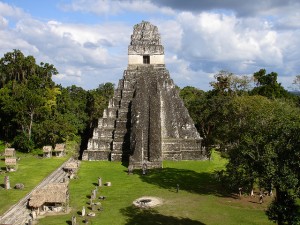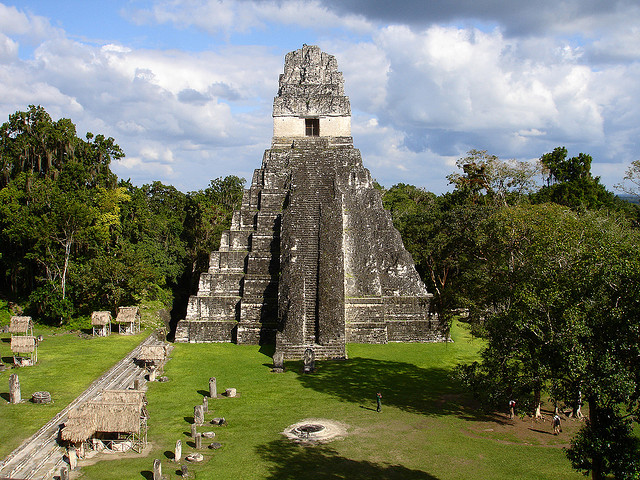Extract of article from Cincinnati University on the largest ancient dam built by the Maya of Central America.
Recent excavations, sediment coring and mapping by a multi-university team led by the University of Cincinnati at the pre-Columbian city of Tikal, a paramount urban centre of the ancient Maya, have identified new landscaping and engineering feats, including the largest ancient dam built by the Maya of Central America.
 That dam – constructed from cut stone, rubble and earth – stretched more than 260 feet in length, stood about 33 feet high and held about 20 million gallons of water in a man-made reservoir.
That dam – constructed from cut stone, rubble and earth – stretched more than 260 feet in length, stood about 33 feet high and held about 20 million gallons of water in a man-made reservoir.
These findings on ancient Maya water and land-use systems at Tikal, located in northern Guatemala, are scheduled to appear this week in the Proceedings of the National Academy of Sciences (PNAS) in an article titled “Water and Sustainable Land Use at the Ancient Tropical City of Tikal, Guatemala.” The research sheds new light on how the Maya conserved and used their natural resources to support a populous, highly complex society for over 1,500 years despite environmental challenges, including periodic drought.
Excavation of the dam identified by the UC-led team. A collapsed sluice gate is outlined in red. Image: UC
Starting in 2009, the UC team was the first North American group permitted to work at the Tikal site core in more than 40 years.
Detailed in the latest findings are:
- The largest ancient dam built by the ancient Maya of Central America
- Discussion on how reservoir waters were likely released
- Details on the construction of a cofferdam needed by the Maya to dredge one of the largest reservoirs at Tikal
- The presence of ancient springs linked to the initial colonisation of Tikal
- Use of sand filtration to cleanse water entering reservoirs
- A “switching station” that accommodated seasonal filling and release of water
- Finding of the deepest, rock-cut canal segment in the Maya lowlands
According to UC’s Vernon Scarborough, “The overall goal of the UC research is to better understand how the ancient Maya supported a population at Tikal of perhaps 60,000 to 80,000 inhabitants and an estimated population of five million in the overall Maya lowlands by AD 700.”
He added, “That is a much higher number than is supported by the current environment. So, they managed to sustain a populous, highly complex society for well over 1,500 years in a tropical ecology. Their resource needs were great, but they used only stone-age tools and technology to develop a sophisticated, long-lasting management system in order to thrive.”
Water storage and collection critical to survival
Water collection and storage were critical in the environment where rainfall is seasonal and extended droughts not uncommon. And so, the Maya carefully integrated the built environment – expansive plazas, roadways, buildings and canals – into a water-collection and management system. At Tikal, they collected literally all the water that fell onto these paved and/or plastered surfaces and sluiced it into man-made reservoirs. For instance, the city’s plastered plaza and courtyard surfaces and canals were canted in order to direct and retain rainwater run-off into these tanks.
In fact, by the Classic Period (AD 250-800), the dam (called the Palace Dam) identified by the UC-led team was constructed to contain the waters that were now directed from the many sealed plaster surfaces in the central precinct. It was this dam on which the team focused its latest work, completed in 2010. This gravity dam presents the largest hydraulic architectural feature known in the Maya area. In terms of greater Mesoamerica, it is second in size only to the huge Purron Dam built in Mexico’s Tehuacan Valley sometime between AD 250-400.
Said Scarborough, “We also termed the Palace Dam at Tikal the Causeway Dam, as the top of the structure served as a roadway linking one part of the city to another. For a long time, it was considered primarily a causeway, one that tourists coming to the site still use today. However, our research now shows that it did double duty and was used as an important reservoir dam as well as a causeway.”
For more detail and the source article, click here
Photo: Temple near where a UC-led team has worked on research related to the ancient Maya’s management of resources.
Photo credit: bunchofpants / Foter / Creative Commons Attribution-NonCommercial-ShareAlike 2.0 Generic (CC BY-NC-SA 2.0)
